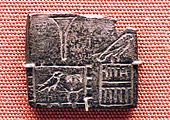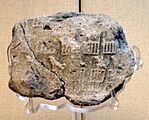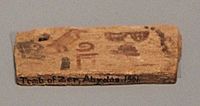Djer facts for kids
Quick facts for kids Djer |
|
|---|---|
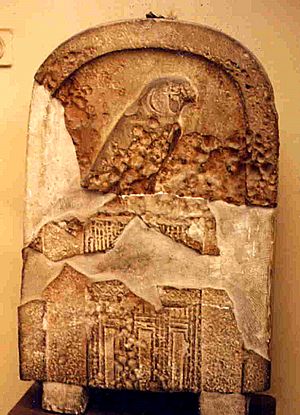 |
|
| Pharaoh | |
| Reign | 41 years, c. 3000 BC (middle of the 1st Dynasty) |
| Predecessor | Hor-Aha |
| Successor | Djet |
| Consort | Nakhtneith, Herneith, Penebui |
| Children | Merneith, Djet ? |
| Father | Hor-Aha |
| Mother | Khenthap ?, Neithhotep ? |
| Burial | Tomb O, Umm el-Qa'ab |
Djer (also known as Zer or Sekhty) was an important pharaoh of ancient Egypt. He is thought to be the third ruler of the First Dynasty. Djer lived around 3000 BC and ruled for about 40 years. During his time, Egypt was still a young kingdom, and its rulers were setting up many traditions.
Contents
What Was Djer's Name?
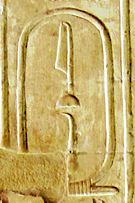
Ancient Egyptians used different names for their pharaohs. The Abydos King List, an old record of kings, calls Djer Iti. Another ancient list, the Turin King List, has a damaged name that starts with It....
A historian named Manetho, who wrote much later, called him Uenéphes. The name Djer, as we know it today, means "Defender of Horus." Horus was a very important god in ancient Egypt, often shown as a falcon.
How Long Did Djer Rule?
Historians have different ideas about how long Djer ruled. Manetho, the ancient Egyptian priest, said Djer ruled for 57 years. However, more recent studies look at older records.
The Palermo Stone is a very old stone tablet that lists the reigns of early pharaohs. It suggests that Djer ruled for "41 complete and partial years." Because the Palermo Stone was made closer to Djer's time, many experts believe it is more accurate than Manetho's writings.
Important Events During Djer's Rule
Before Djer became pharaoh, a queen named Neithhotep might have ruled for him. She was possibly his mother or grandmother.
We know about Djer's reign from several discoveries:
- His tomb in Umm el-Qa'ab, a famous burial site in Abydos.
- Seal prints found in graves at Saqqara.
- Inscriptions in other tombs in Saqqara and Helwan.
- A jar from Turah with Djer's name on it.
- An ivory tablet from Abydos and a copper tool, both with Djer's name.
- An inscription in Wadi Halfa, Sudan, which might be from his time.
Some writings on ivory and wood are in very early forms of hieroglyphs. This makes them hard to fully understand. One ivory tablet from Abydos tells us that Djer visited important cities in the Nile Delta, like Buto and Sais. The Cairo Stone mentions a year of his reign called "Year of smiting the land of Setjet." This likely means Djer led a military campaign to a place like the Sinai Peninsula or beyond.
Djer's Family
Djer was the son of the pharaoh Hor-Aha. His mother might have been Khenthap. His grandfather was probably Narmer, another very early and important pharaoh.
Djer had a daughter named Merneith. She later became the wife of Djet, who was Djer's successor. Merneith was also the mother of Den, another pharaoh.
Several women were buried near Djer's tomb or are mentioned in records. They are thought to be his wives:
- Nakhtneith: Her stela (a carved stone slab) was found in Abydos.
- Herneith: She was possibly one of Djer's wives and was buried in Saqqara.
- Seshemetka: She was buried next to Djer in Abydos.
- Penebui: Her name was found on an ivory label.
Djer's Burial Place
Like his father, Hor-Aha, Djer was buried in Umm el-Qa'ab at Abydos. His tomb is known as tomb O. Inside his tomb, archaeologists found the remains of 318 people who were buried with him. These people were likely his loyal followers.
At some point, Djer's tomb was damaged by fire. Later, during the Middle Kingdom period, Djer's tomb became a very important religious site. People believed it was the tomb of Osiris, the god of the afterlife. An image of Osiris was even placed in the tomb.
Many interesting items were found in and around Djer's tomb:
- A stela of Djer, which is now in the Cairo Museum.
- Labels that mention a palace and the name of Merneith.
- Pieces of two vases with the name of Queen Neithhotep.
- Bracelets belonging to a queen, found in the tomb wall.
In the smaller tombs around Djer's, excavators found more stelae, ivory objects with Neithhotep's name, and other ivory tablets.
Ancient records suggest that the First Dynasty pharaohs, including Djer, ruled from Memphis. This is supported by the fact that one of Djer's wives, Herneith, was buried near Memphis at Saqqara.
Images for kids
-
Seal impression with the serekh of Djer found in Abydos, on display at the British Museum
-
Ceremonial flint knife with the Horus name of Djer inscribed on its gold handle, on display at the Royal Ontario Museum.
-
Close-up view of Djer's serekh on the ceremonial flint knife of the Royal Ontario Museum.
See also
 In Spanish: Dyer (faraón) para niños
In Spanish: Dyer (faraón) para niños


